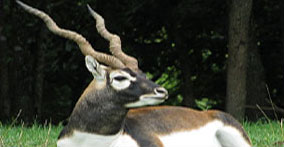Haryana State’s Emblems
State Tree – Pipal, Peepul or Bo tree (Ficus religiosa)
Pipal tree (Ficus religiosa), a native tree of India, has been declared state tree of Haryana. All parts of the Pipal tree, including roots, bark, leaf and fruit, are useful. The botanical classification of the Pipal tree is:
 Division: Magnoliophyta, Class: Magnoliopsida, Order: Urticales, Family: Moraceae
Division: Magnoliophyta, Class: Magnoliopsida, Order: Urticales, Family: Moraceae
Latin Name : Ficus religiosa.
English Name: Sacred fig, The Holy Big Tree
Sanskrit Name: Ashwath
Description of the Plant: Large tree, Flower color-red. Flowers in February. Fruits in May / June. Widely found in uplands and plain area.
Plant parts used: Root / Bark / Leaf / Fruit.
Medicinal uses: The bark of the tree is useful in inflammations and glandular swelling of the neck. It’s root bark is useful for stomatitis, cleans ulcers, and promotes granulations. Its roots are also good for gout. The roots are even chewed to prevent gum diseases. Its fruit is laxative which promotes digestion and checks vomiting. Its ripe fruits are good for the foul taste, thirst and heart diseases. The powered fruit is taken for Asthma. Its seeds have proved useful in urinary troubles. The leaves are used to treat constipation.
State Flower – Lotus
 The Lotus or the Water Lily is an aquatic plant with broad floating green leaves and bright fragrant flowers that grow only in shallow waters. Based on the color of its flower, it is divided into two types, the red lotus flower and the white lotus flower. The beautiful flowers float and have many petals overlapping in a symmetrical pattern. Lotuses, prized for their serene beauty, are delightful to behold as their blossoms open on the surface of a pond.
The Lotus or the Water Lily is an aquatic plant with broad floating green leaves and bright fragrant flowers that grow only in shallow waters. Based on the color of its flower, it is divided into two types, the red lotus flower and the white lotus flower. The beautiful flowers float and have many petals overlapping in a symmetrical pattern. Lotuses, prized for their serene beauty, are delightful to behold as their blossoms open on the surface of a pond.
State Animal – Black Buck (Antelope)
Black Buck, common name for an antelope, mainly is a resident of India but with other small populations in Pakistan and Nepal. The Black Buck has ringed horns that have a moderate spiral twist of three to four turns and are up to 70 cm (28 inch) long. The name Black Buck has also been applied to the sable antelope of Africa. The adult male stands about 80 cm (about 32 inch) at the shoulder and weighs 32 to 43 kg (71 to 95 lb). The body’s upper parts are black; the underparts and a ring around the eyes are white. The light-brown female is usually hornless. Males are dark brown.
 Kala Hiran is also called Indian Black Buck Antelope (Antelope/cervicapra L.). It has four sub species, they are:
Kala Hiran is also called Indian Black Buck Antelope (Antelope/cervicapra L.). It has four sub species, they are:
Antelope cervicapra cervicapra
Antelope cervicapra rajputanae
Antelope cervicapra centralis
Antelope cervicapra rupicapra
State Bird – Black Francolin
Black Francolin (Francolinus francolinus), sometimes known as Black Partridge, is a widespread breeding resident in most of north and central India. Called Kala Teetar in Hindi, this handsome stub-tailed game bird is found near cultivation and scrub, bordering wetlands. Black Francolin prefers crops, grass and bushes, tall enough to offer shelter and open beneath to provide easy escape on ground. It is more closely associated with water than the Grey Francolin.
Size: 34 cm
 The male Black Francolin is black with white patch on the cheek, a chestnut collar and white spots on the flanks. The back and wings are scalloped with shades of golden brown with sub-terminal tawny-buff bands and pale edges. Tail is black with narrow white bars. Legs are reddish-brown to red. The female Black Francolin similar to the male, but is paler, with wider brown bars on the lower back, the white cheek patch is missing and the chestnut collar replaced by a nuchal patch.
The male Black Francolin is black with white patch on the cheek, a chestnut collar and white spots on the flanks. The back and wings are scalloped with shades of golden brown with sub-terminal tawny-buff bands and pale edges. Tail is black with narrow white bars. Legs are reddish-brown to red. The female Black Francolin similar to the male, but is paler, with wider brown bars on the lower back, the white cheek patch is missing and the chestnut collar replaced by a nuchal patch.
Food consists mainly of grain, grass seeds, fallen berries, shoots, tubers, termites, ants and insects.


